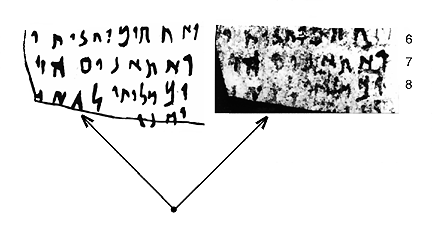By Norman Golb, Ludwig Rosenberger Professor in Jewish History and Civilization
Oriental Institute
University of Chicago
The just-published Qadmoniot 30 (114) 1997/98: 134-136 article by E. Eshel and F. M. Cross contains a photograph of the so-called "Yahad" ostracon which is as poor as, if not poorer than, the one appearing in their earlier IEJ article on the subject (vol. 47, nos. 1-2, 1997, pp. 17 ff.). Students of Hebrew palaeography and of the Qumran texts can hardly be expected to draw serious conclusions about the nature of this ostracon from such inadequate images. Even the ones appearing in Haaretz - a daily newspaper rather than a scientific journal (see issues of 18 July and 15 Aug. '97)) - are better.
As a matter of elementary method, terms in ancient texts claimed to have large historical significance should, when published, be shown in magnification and with as much color or black-and-white contrast as modern photography can normally achieve. The so-called "Yahad" reading, given all that has been claimed for it, can hardly be considered to warrant exemption from that basic mode of procedure. For whatever reason, Eshel and Cross did not offer a serious enlargement of the crucial line 8 of the text, nor even of its all-important word, in either of their articles.

A blow-up of the term in question, along with the hand-drawn transcription of it by E. Eshel appearing in the two articles.
From the blow-up - but not from the photographs appearing in IEJ and Qadmoniot - viewers will be able to discern, with the aid of the appended markers, an obvious discrepancy between the text itself and the Eshel transcription at precisely that most important word: The transcription shows a conceivable, if somewhat overly large, arrowhead-type yod, with two vertical strokes angling upward toward each other and meeting at the top,and having no horizontal stroke to spoil the picture. This is supposed to constitute what the authors claim to be the first consonant of the word "yahad." The blow-up of the photograph itself, however, shows only one vertical stroke, on the right, plus a clear horizontal stroke below and attached to it. These two strokes reasonably form only a nun or gimel. No specimen of ancient or medieval Hebrew script contains a yod formed in such a manner.
The conclusion is unavoidable that the transcription by Dr. Eshel does not faithfully follow the strokes of the pertinent consonant in the ostracon. By virtue of the actual shape of that first consonant itself, the word of which it forms the initial part cannot be the claimed "yahad" as championed by the authors and as supported by the curators of the Shrine of the Book in their current exhibit entitled "Daily Life at Qumran". Whether the following consonant, which has the same appearance as several alephs occurring in the ostracon, is or is not to be construed as a rare form of the consonant het making a solo appearance in this text, and whether the piece of a third consonant that follows it is or is not the upper minuscule portion of a daleth, are moot questions in respect to the large historical claim being championed by the aforementioned parties. A simple enlargement focusing on the crucial word proves that claim to be baseless.
As for the claim itself, it is to the effect that this ostracon, being found just outside the walls of Qumran and having reference to the "Yahad" sectarian community commonly believed to have inhabited Khirbet Qumran, is the "first find from Khirbet Qumran that provides proof of the link between the site and the scrolls," its discovery confirming "that the site served as the community center of the sect." (E. Eshel and F. M. Cross in A. Roitman [ed.], A Day at Qumran - the Dead Sea Sect and its Scrolls [Israel Museum Catalogue no. 394, Jerusalem 1997] p. 40.) The crucial word does not appear in the ostracon, thus vitiating the very large historical claim being made for it and still being presented to visitors to the Shrine of the Book,on a daily basis, as a fact.
P.S. The clear blow-up of the crucial term was first presented by me during my lecture at the Jerusalem Scroll Conference of the past July - i.e., over six months ago. Anyone who magnifies the Haaretz publication at the appropriate point will secure approximately the same result.

